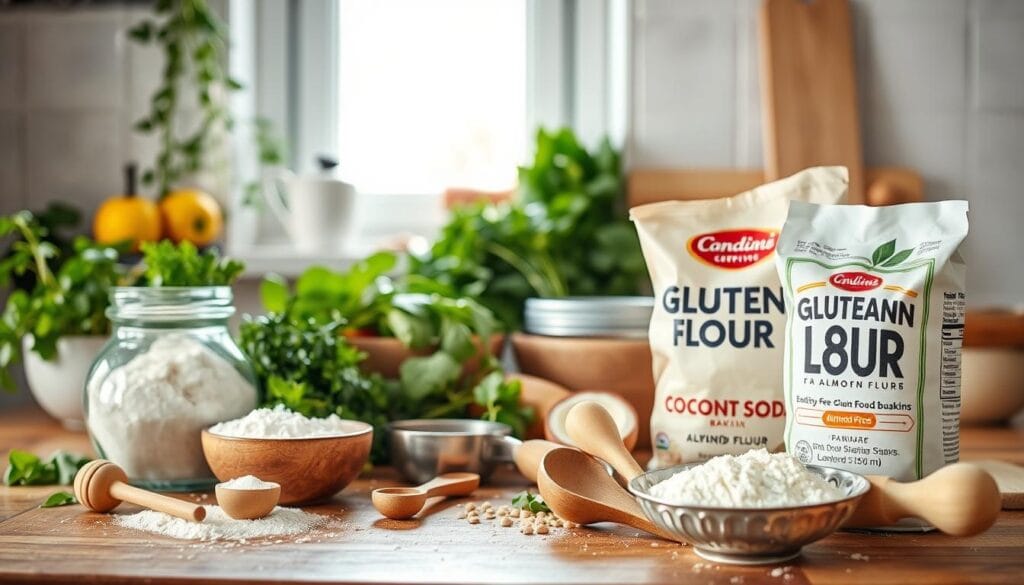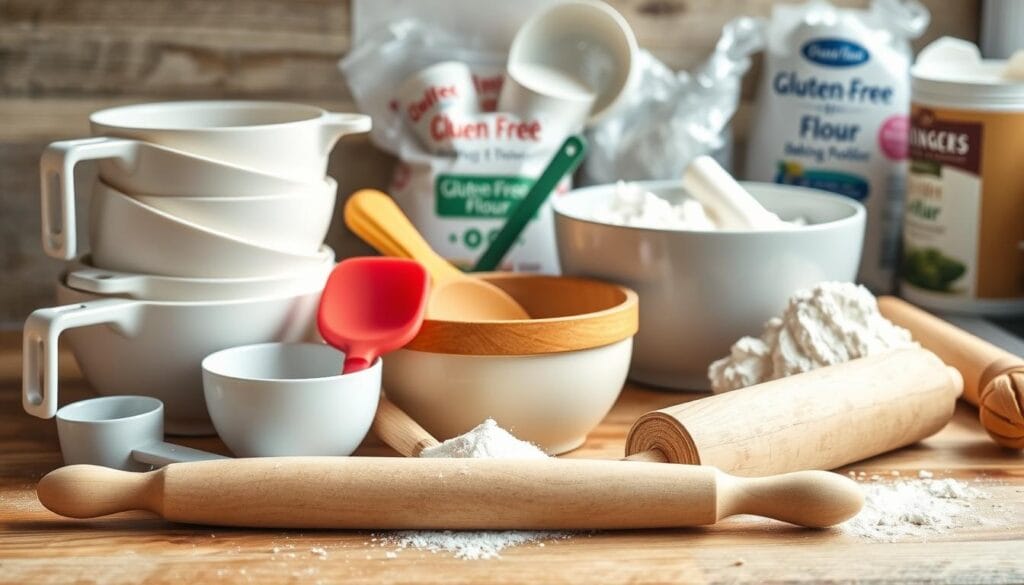Are you tired of flat, crumbly biscuits that don’t taste anything like the real deal? Don’t worry—you’re not alone! Gluten-free baking can feel like solving a tricky puzzle, but with the right techniques, ingredients, and a little patience, you can whip up biscuits so good, no one will guess they’re gluten-free. Let’s crack the code to perfect gluten-free biscuits together!
Table of Contents
Introduction to Gluten-Free Baking
Gluten-free baking isn’t just about swapping out regular flour for something fancy. It’s a whole different ballgame! Gluten, the stretchy protein found in wheat, gives traditional biscuits their fluffy, tender texture. Without it, things can go sideways fast. But hey, don’t lose hope! We’ll uncover tips and tricks to help you master this art.
“Gluten-free baking is like learning a new dance—it’s tricky at first, but once you get the rhythm, it’s pure joy!” 💃
Why Gluten-Free Baking is Different
In regular baking, gluten traps air and creates structure, like scaffolding for your biscuits. But in gluten-free baking, you’re working without that magical net. This is why your gluten-free treats might feel dry or crumbly at first. No worries—we’ll fix that!
Importance of Getting Biscuits Right 💪
Why all this fuss over biscuits? Well, they’re more than just a side dish—they’re comfort food! Whether you’re slathering them with butter, dipping them in soup, or turning them into mini sandwiches, biscuits deserve to shine. And when you nail the perfect gluten-free biscuit, it’s a game changer. Trust me, your taste buds will thank you!
Common Challenges in Gluten-Free Biscuit Baking
Before diving into the recipe, let’s talk about the struggles. (Because if we don’t know what’s wrong, how can we fix it?)
Texture Troubles: Avoiding Dry and Crumbly Biscuits
One of the biggest complaints is that gluten-free biscuits feel like sandcastles—crumbly and dry. This happens when there’s not enough moisture or the wrong flour mix. We’ll fix this with the right ratio of wet-to-dry ingredients and some secret binding agents.
Flavor Pitfalls: Ensuring They Taste Just Right 😋
Another issue? That weird aftertaste. Some gluten-free flours, like sorghum or rice flour, can have a distinct flavor. Balancing this with fats (like butter) and other flavor boosters (like buttermilk) makes all the difference.
Difficulty in Achieving Fluffiness ☁️
If your biscuits feel like hockey pucks instead of fluffy pillows, you’re not alone. Without gluten, it’s tricky to get lift and structure. But with some leavening magic (hello, baking powder and soda) and gentle handling, fluffy biscuits are totally possible!
Essential Ingredients for Gluten-Free Biscuits 🛒

Let’s talk ingredients. The right ones can turn a biscuit fail into a total win.
Selecting the Best Gluten-Free Flour Blends 🥣
Not all gluten-free flours are created equal. Some are gritty, others are too starchy, and most aren’t great on their own. The best blends usually combine rice flour, tapioca starch, and potato starch for a balanced texture. Or, you can DIY your mix!
| Type | Texture | Common Uses |
|---|---|---|
| Rice Flour | Fine and neutral | General baking |
| Almond Flour | Moist and nutty | Cakes, cookies |
| Sorghum Flour | Earthy and hearty | Bread, biscuits |
Role of Binders: Xanthan Gum and Psyllium Husk
These are your secret weapons. Xanthan gum acts like glue, holding everything together. Psyllium husk, on the other hand, adds moisture and elasticity. They’re not optional if you’re serious about gluten-free baking!
Additional Ingredients for Flavor and Texture 🍋
Don’t forget the extras! Buttermilk adds tang and tenderness, butter creates richness, and a dash of sugar balances the flavors. A sprinkle of salt? Absolutely essential—it brings everything together.
Tools You Need for Perfect Biscuits

You don’t need a fancy setup, but a few tools make life easier.
Must-Have Kitchen Equipment
- Biscuit Cutter: For those classic round shapes.
- Mixing Bowls: One big, one small—you’ll thank me later.
- Rolling Pin: Though honestly, your hands work just fine!
Optional Tools to Elevate Your Baking ✨
- Pastry Blender: Perfect for cutting butter into flour.
- Silicone Baking Mat: Ensures an even bake.
Step-by-Step Guide to Making Gluten-Free Biscuits 🥐
Ready to bake? Let’s get rolling!
Prepping Your Ingredients
First things first—measure everything. Gluten-free baking is all about precision. Too much flour? Dry biscuits. Too much liquid? Gummy mess. Keep a scale handy if you’ve got one.
Mixing the Dough: Tips and Tricks 👩🍳
Combine your dry ingredients first: flour blend, xanthan gum, salt, sugar, and leavening agents. Then, cut in your butter until the mix looks like coarse crumbs. Finally, add your wet ingredients—buttermilk and an egg—and mix just until combined. Overmixing is your enemy!
Shaping and Cutting Biscuits for Even Baking
Turn your dough onto a floured surface and gently pat it down. Don’t use a rolling pin—it’s too rough. Use a biscuit cutter or a drinking glass to cut out shapes. Pro tip: Press straight down—no twisting, or you’ll seal the edges and prevent proper rise.
Baking to Perfection: Time and Temperature Tips 🔥
Here’s where the magic happens. Preheat your oven to 425°F (220°C)—a hot oven is crucial for getting that beautiful rise and golden top. Place your biscuits on a parchment-lined baking sheet, making sure they’re slightly touching. Why? It helps them rise better, like a supportive group of friends lifting each other up. Bake for 12-15 minutes, or until the tops are golden and the edges crisp.
“Hot ovens and a watchful eye are the secret ingredients to biscuit bliss.” 🕶️
Troubleshooting Common Problems 🚧
Sometimes, even when you follow the steps, things go sideways. Don’t panic! Here’s how to troubleshoot and save your biscuits.
Why Are My Biscuits Falling Apart?
If your biscuits crumble like dry sand, it’s likely due to a lack of moisture or binding agents. Next time, try adding a little more buttermilk or an extra teaspoon of xanthan gum. Also, don’t skip resting your dough for 5-10 minutes before baking—it lets the moisture distribute evenly.
How to Fix Dense or Gummy Biscuits
Dense biscuits are often the result of overmixing or too much liquid. Be gentle when combining your ingredients, and if your dough feels overly sticky, add a tablespoon of gluten-free flour at a time until it’s workable. Remember: less is more when it comes to handling the dough.
Salvaging Overbaked or Undercooked Biscuits 🕰️
Overbaked biscuits? Brush them with melted butter and wrap them in a damp towel while they cool—it softens them up. Undercooked in the center? Pop them back in the oven for a few extra minutes, covering the tops with foil to prevent burning.
Tips for Storing and Reheating Gluten-Free Biscuits
Best Practices for Keeping Biscuits Fresh
Store your biscuits in an airtight container at room temperature for up to two days. For longer storage, freeze them in a zip-top bag. When freezing, place parchment paper between layers to prevent sticking.
How to Reheat Without Losing Quality
Reheat biscuits in a 350°F (175°C) oven for 5-7 minutes. Avoid microwaving if you can—it makes them soggy. For frozen biscuits, thaw them at room temperature first, then warm them in the oven.
Creative Variations of Gluten-Free Biscuits
Why stick to plain biscuits when you can get creative? Here are some fun twists to try.
Sweet Biscuits: Adding Fruits and Flavors 🍓
Mix in dried fruits like cranberries or raisins, or add a splash of vanilla and a sprinkle of cinnamon to the dough. These sweet biscuits pair perfectly with morning coffee or a drizzle of honey.
Savory Biscuits: Cheese, Herbs, and More 🧀
Add shredded cheddar cheese, chopped chives, or crumbled bacon for a savory kick. These biscuits are perfect alongside soups and stews or as a base for breakfast sandwiches.
Pairing Ideas: What to Serve with Gluten-Free Biscuits
Breakfast Pairings: Eggs, Bacon, and Gravy
Start your day right! Top your biscuits with scrambled eggs, crispy bacon, or a generous ladle of sausage gravy for a hearty breakfast.
Dinner Pairings: Soups, Stews, and Casseroles
Biscuits are the ultimate comfort food side dish. Serve them with a warm bowl of chicken noodle soup or a rich beef stew. They’re also great for sopping up sauces in casseroles.
Expert Tips for Mastering Gluten-Free Biscuit Baking
Practice Makes Perfect: Keeping a Baking Journal
Every oven, flour blend, and recipe tweak is unique. Keep a baking journal to note what works and what doesn’t. Over time, you’ll refine your technique and create biscuits that are just right for you.
Experimenting with Different Ingredients 🌿
Don’t be afraid to try new things! Swap out buttermilk for yogurt, or add a pinch of nutmeg for a flavor twist. The key is to have fun and enjoy the process.
Conclusion: Enjoying the Perfect Gluten-Free Biscuits
And there you have it! With these tips, tricks, and a foolproof recipe, you’re ready to conquer gluten-free biscuit baking. Remember, it’s not about perfection—it’s about making something you love. So go ahead, grab your apron, and get baking. Your taste buds are in for a treat!
“The only thing better than a perfect biscuit is the journey of making it. Happy baking!” 🥰

